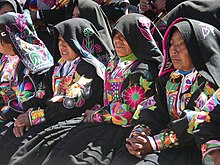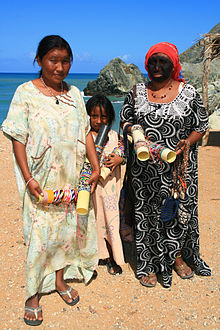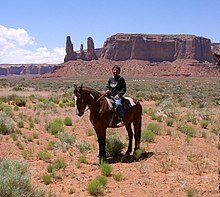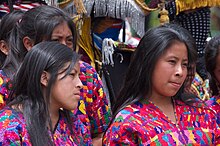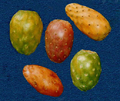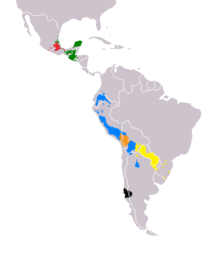Indigenous people of america
The Indians of the Americas, also called American Indians, Amerindians, Native Americans, Original of America or American Indians are the original settlers of America and their descendants who maintain their culture or recognize themselves as such. Some authors exclude Eskimos from among the Amerindians and sometimes also the Nadené language peoples, since according to the Amerindian hypothesis their ethnolinguistic origin and arrival in America itself was later.
Origin of name
The voyages of Christopher Columbus in 1492 sought to reach a route to Asia that would allow him to avoid passing through the eastern Mediterranean, then blocked by the Turks. Columbus' overly optimistic calculations led him to believe that the western route was shorter than it really is. Arriving in America, approximately within the period that his calculations indicated that he would reach the shores of Cipango —present-day Japan—, he did not recognize the territory for what it was, and instead believed that he had reached "the Indies," the name generic for Far East Asia.
The “discovery of America” was not recognized as such at first, and it would not be until years later that Amerigo Vespucci would discover the error. The natives of the discovered lands were called, by virtue of the confusion, "Indians."
Although Vespucci's discovery made it possible to correct cartography, in linguistic usage the confusion was perpetuated in the name given to the natives. In most European languages, the word Indian is the same for native Indians and indigenous American peoples. In some, however, there are two different words; for example, the natives of India in German are called Inder and the American peoples are called Indianer.
In the 20th century, calling the original natives of the “New World” Indians, or its English equivalent, Indian, became politically incorrect and a series of accepted alternate names emerged in both Spanish and English. The terms American Indian, indigenous, American Indian, Amerindian and native have been in force in Spanish, and the terms American Indian, Native American and First Nations were some of the new names used in English.
Although the vast majority of countries in the Americas have indigenous populations, they are the majority only in Guatemala and Bolivia, while in Mexico, Peru and Ecuador these populations are smaller but significant, since these countries contain more of mestizos, unlike the first two, who had little miscegenation.
In Paraguay, the indigenous language Guarani has been one of the two official languages of the country since the National Constitution of 1992.
In the United States, Indian reservations have "sovereign" status, and their tribal laws and governments are above municipal regulations and state laws, and below only federal laws and the Constitution, which establishes a "government-to-government" relationship (see tribal sovereignty, on the English Wikipedia)
| Country | Indigenous | Part
indigenous | Total
combined |
|---|---|---|---|
| North America | |||
| Greenland | 89 % | 89 % | |
| Canada | 1.8 % | 3.6 % | 5.4 % |
| Mexico | 10.1% | ||
| Dominican Republic | |||
| Grenada (isla) | ~0.4 % | ~0 % | ~0.4 % |
| Haiti | ~0 % | ~0 % | ~0 % |
| Jamaica | |||
| Puerto Rico | 0.4 % | 84 % | 84.4 % |
| San Cristóbal y Nieves | |||
| Saint Lucia | |||
| Saint Vincent and the Grenadines | 2 % | 2 % | |
| Trinidad and Tobago | 0.8 % | 8% | 88% |
| Central America | Indigenous | Part
indigenous | Total
combined |
| Guatemala | 43.5 % | 56 % | 99.5 % |
| South America | Indigenous | Part
indigenous | Total
combined |
| Argentina | 2.38 % | 27 % | 29.38 % |
| Bolivia | 20% | 68 % | 8% |
| Brazil | 0.4 % | 23 % | 23.4 % |
| Chile | 4.6 % | 4.6 % | |
| Colombia | 4.4 % | 49 % | 53.4 % |
| Ecuador | 25 % | 65 % | 90 % |
| French Guiana | |||
| Guyana | 10.5 % | 10.5 % | |
| Paraguay | 1.7 % | 95% | 96.7 % |
| Peru | 25.8 % | 60.2 % | 86 % |
| Suriname | 2 % | 2 % | |
| Uruguay | 2.4% | 38 % | |
| Venezuela | 2.7 % | 51.6 % | 54.3% |
History
According to the most well-known and accepted theory of the population of America, Native Americans descend from groups of hunter-gatherers of Siberian origin who migrated to America through the Bering Strait during the last Würm glaciation. However, recent controversial discoveries, such as Pedra Furada, in Brazil, and Monte Verde, in Chile, seem to contradict this theory, and indicate possible pre-Siberian colonization. As in the rest of the world, except in Africa, the human colonization of these lands was accompanied by the virtual extinction of all the local megafauna, except for some bovids, such as bison. Around 2500 B.C. C. there were already important agricultural communities, such as the civilization of Caral, in Peru, whose oldest traces date back to 3000 BC. C. The Valdivia Culture, for its part, is a culture that developed between 3800-3500 BC. C. in the current province of Santa Elena in present-day Ecuador, becoming the oldest ceramic culture in America, although it should be mentioned that 10,000 a. C. in Ecuador there was already the Las Vegas Culture, which is believed to have domesticated gourd and mate, and the La Tolita Culture from 600 BC. C. who were the first in the history of humanity to make goldsmithing with platinum.
Pre-Columbian high cultures arose in Mesoamerica and South America. From north to south we can name the Mexicas, Mixtecs, Toltecs, Mayas, Chibchas and Incas. On the other hand, in North America human settlements did not reach a cultural level as complex as in the aforementioned civilizations, partly due to their lower population density and, above all, due to their semi-nomadic activities.
It is believed that in the 11th century AD century AD, Vikings of Norwegian origin established the first European colonies in the Americas, specifically in what is now called Nova Scotia, although his stay must have been very brief and his impact on the Native Americans not very important.
From 1492, the European colonization of America began. The Spanish Empire expanded into the territories of America under the banner of evangelization. Spanish colonization brought the replacement of local government systems and the imposition of administrations subject to the Crown of Castile. Along with military actions, the subjection of the natives to systems of forced labor —mitas, encomiendas, and other regimes— and contact with diseases for which they lacked antibodies caused an abrupt reduction in the American Indian population. In the regions of Portuguese, English, and French colonization, American Indian cultural continuity has been less, as has just been pointed out; being that in regions of Castilian sovereignty, the native customs were preserved in their great majority.
In Peru, Bolivia, Ecuador, Paraguay, and the province of Corrientes (Argentina) there are indigenous languages with co-official rank along with Spanish. Greenland has the Greenlandic language as its only official language. In addition, both in Paraguay, Mexico and Venezuela, indigenous languages have achieved recognition as national languages, although compared to other countries, in Mexico a very small percentage of the country speaks an indigenous language, in 2020 only 6.2% of Mexicans were registered by INEGI (National Institute of Statistics and Geography) as being able to speak an autochthonous language and with 93% of indigenous people in Mexico being native Spanish speakers as monolingual or bilingual speakers of Spanish as a second language.
Cultural aspects
The culture of Native Americans varies greatly. Language, clothing, and customs vary greatly from one culture to another. This is due to the extensive distribution of the Americans and the adaptations to the different regions of America. For example, due to the semi-desert region, the Chichimecas of Aridoamerica never came to form a civilization like those of Mesoamerica, their neighbors to the south. As a consequence of this, the Chichimecas formed a culture based on the practice of nomadism. Although the Aztecs and Incas formed extensive and rich civilizations, the clothing of both depended heavily on the climate of their lands. In Mesoamerica, where the climate is hotter, they used to wear less clothing than the inhabitants of the Andes. Even so, there are some cultural characteristics that most Native Americans practiced.
Music
Wires and percussion were the instruments mostly used by the indigenous cultures of America. In almost all of the United States and Canada, the music was accompanied by monophonic percussion. It is believed that in central Mexico and Central America the music was made from pentaphonic scales. It is usually considered that before the arrival of the Spanish, music was inseparable from religious festivities, festivities that included a great variety of wind and percussion instruments such as drums, flutes, conch shells (used as trumpets) and rain pipes.. Regarding string instruments, some groups came to use them using natural elements (fruits and hollowed-out trunks) and even the oral cavity as a resonance box; Usually only two or three strings were used, stretched over a bow, which were plucked, with or without a plectrum, without forming what in the West is known as harmony.
After the arrival of the Spaniards, the process of spiritual conquest was favored, among other things, by the liturgical musical service to which the natives were integrated, whose musical gifts came to surprise the missionaries. The musical gifts of the natives were of such magnitude that they soon learned the rules of counterpoint and polyphony and even the virtuoso handling of the instruments, this helped to prevent more musicians brought from Spain from being requested, which significantly annoyed the clergy.[citation required] The solution that was proposed was not to employ more than a certain number of indigenous people in the musical service, not to teach them counterpoint, not to allow them to play certain instruments (brass brass, for example, in Oaxaca, Mexico) and, finally, not to import more instruments so that the indigenous people did not have access to them. The latter was not an obstacle to the musical enjoyment of the natives, who experimented with the construction of instruments, particularly bowed strings (violins and double basses) or plucked strings (tercerolas), it is there where we can find the origin of what is now called traditional music whose instruments they have their own tuning and a typical western structure.[citation needed]
Regarding the fusion of musical traditions, in Mexico two small sacred works by Don Hernando Franco are preserved, Dios itla tonantzin and In ilhuicac, which combine the method Western contrapuntal, with the Nahuatl language and a not very common rhythm that introduces what seem to be some contrapuntal errors that are caused more than accidents.
Agriculture
Over the course of a thousand years, many plant species were domesticated, created, and cultivated in the Americas. It is estimated that more than half of the world's crop production comes from plants initially developed by the indigenous people of the Americas. In many cases, indigenous people created entirely new species from existing wild ones, such as maize created from wild teosinte from the northern valleys of Guatemala. A large number of these agricultural products still keep their names adapted from the word in Nahuatl or Quechua.
Among the agricultural techniques developed by the American Indians are the association of crops such as the Mesoamerican milpa or the Andean farm, cultivation on terraces and various kinds of irrigation systems. The Amazon black earth is a very fertile soil created by human action, but it is disputed if its formation was intentional.
Among the food treatment techniques, nixtamalization stands out, which increases the availability of corn nutrients, and the preparation of chuño (freeze-dried potatoes).
A partial list of crops of American origin includes:
Principal crops in North America (also known as the four sisters):
- corn or choclo (Zea mays)
- pumpkin or zapalloCucurbita)
- beans, beans or poroto (beans)Phaseolus vulgaris)
- tomatoes or tomatoesSolanum lycopersicum)
Other crops known worldwide are:
|
|
Regionally grown:
|
|
Amerindian protein sources:
- sunflower or wonder (Helianthus annuus)
- pecan (Carya illinoinensis)
- araucaria or pehuén pineapple (Araucaria araucana)
Ceremonial uses:
- tobaccoNicotiana tabacum, Nicotiana rustica)
- CocaErythroxy Cocalum)
- peyote (Lophophora williamsii)
- ayahuasca (decoction of Banisteriopsis caapi with Psychotria viridis or Diplopterys cabreranaamong other plants
- yerba mate (Ilex paraguariensis)
- willka, cebil, cohoba, yopo (Anadenanthera colubrina, Anadenanthera pilgrim)
Other crops:
- rubber (Hevea brasiliensis)
- gumManilkara zapota)
- cottonGossypium), whose cultivation began independently in America and India.
- quina (Cinchona officinalis)
- achioteBixa orellana)
Technology
The limited distribution of pack animals available for domestication is undoubtedly one of the factors that made transportation difficult in pre-Hispanic America. In addition, the configuration of the continent oriented according to the north-south axis made the diffusion of certain crops difficult as the climate varied greatly with latitude. Note that Eurasia has a predominant east-west orientation, which allowed the diffusion of certain technologies and crops along strips in which the latitude varied little.
When the Europeans arrived in America, metallurgy was of limited use and little diffusion. Virtually all American societies in pre-Columbian times used stone tools.
In some particular respects, the American civilizations achieved important successes. In Mesoamerica, knowledge of the calendar and astronomy had reached remarkable levels of development. Regarding agriculture, the Mexicas used intensive agriculture systems based on chinampas with total food production per hectare probably much higher than that of other places on the planet, while the Incas used a system of terraces in order to take advantage of the land. rugged area in which they developed, better irrigating the soil, and obtaining a large food production, which allowed population growth in the Andes area. Even some of the American crops were especially productive, corn when it was brought to China for example, solved to a large extent problems of hunger and was a cofactor responsible for the population explosion of that geographical area towards the century XVIII.
Language
The American continent is one of the most diverse areas in terms of the number of languages and the number of language families. There is documentation of about 900 different indigenous languages, although the original number would have been higher and a number of languages disappeared without being documented. Currently there are still around 500 languages with speakers, most of them with only a few thousand speakers. The phylogenetic classification of the indigenous languages of America groups them into some 80 well-established phylogenetic units, in addition to more than a hundred other unclassified languages. Longer-range comparisons that attempt to prove the relationship between these language families are controversial, since they frequently resort to techniques that are not as demanding as the strict comparative method. Among the long-range classifications, probably the most controversial and also one of the most influential is the Amerindian hypothesis due to Joseph Greenberg (1987) which suggests that Native American languages can ultimately be grouped into three phylogenetic units:
- The amerindian languages proper, which encompassed the vast majority of American languages.
- Esquimo-Germanian languages, which would form part of a supposed Euro-Asian macrofamily.
- Na-dene languages, which would form part of the hypothetical dene-caucasic macrofamily.
Greenberg further proposes a division into groups of Amerindian languages on linguistic evidence. However, most Americanists consider the evidence on which Greenberg is based insufficient to make his result reliable, and in fact, other specialists such as Campbell consider Greenberg's proposal not only inconclusive, but also highly speculative.
Anthropological and genetic aspects
Amerindians as a whole represent one of the human populations where blood group O is most common within the ABO system. On no other continent does the native population have such a high percentage of that blood group. DNA analysis in its three different fields (autosomal, mitochondrial and Y-chromosome genetics) shows that there is an evident closeness between all the native peoples of America. Thus, we find high genetic uniformity throughout the continent, greater than in any other. At the same time, these analyzes confirm the theories of the peopling of America from the Siberian region towards the end of the Ice Age.
Indigenous population statistics
The following table presents an estimate of the Amerindian population in the countries of the Americas. In addition, the calculation of the mestizo population with some indigenous ancestry and the sum of these with the Amerindians themselves are included. It should be noted that these categories are very loosely defined and measured in different ways in each country. In fact, in most of the American countries there are no reliable data on the ethnicity of its inhabitants. The number of native language speakers in the Americas is often equated with the number of indigenous people; however, this data excludes the ethnic population of each linguistic community that has abandoned the use of their native language but continues to be indigenous by culture or because they assume that identity. On the other hand, another statistical challenge consists in determining what part of the population of a country could be considered indigenous due to its genetic heritage. The data presented in the table below comes from The World Factbook, a source external to Latin American countries that calculates the ethnic components of the population of each nation.
It should be said that the censuses carried out in almost all the countries of the Americas reflect the population that self-identifies as belonging to any of the indigenous peoples, either by language, cultural affinity or any other factor.
| Indigenous peoples of the Americas Calculated as a percentage of the total population of each country | ||||
|---|---|---|---|---|
| Country or Region | Percentage of population | |||
| Greenland | 8% | |||
| Bolivia | 44 % | |||
| Guatemala | 42 % | |||
| Peru | 41 % | |||
| Chile | 12.8 % | |||
| Panama | 12.5 % | |||
| Mexico | 10.1 % | |||
| Ecuador | 7 % | |||
| Honduras | 7 % | |||
| Canada | 5.1 % | |||
| Nicaragua | 5 % | |||
| Colombia | 3.4 % | |||
| Dominica | 2.9% | |||
| Venezuela | 2.7% | |||
| Argentina | 2.4% | |||
| Costa Rica | 2.4% | |||
| Paraguay | 1.8 % | |||
| United States | 2.9% | |||
| Brazil | 0.5 % | |||
| Uruguay | 2.4% | |||
| El Salvador | 0.2 % | |||
| Cuba | ND | |||
| Jamaica | ND | |||
| Haiti | ND | |||
| Puerto Rico | ND | |||
| Dominican Republic | ND | |||
Contenido relacionado
Greek language
Josephus Flavius
Albania
